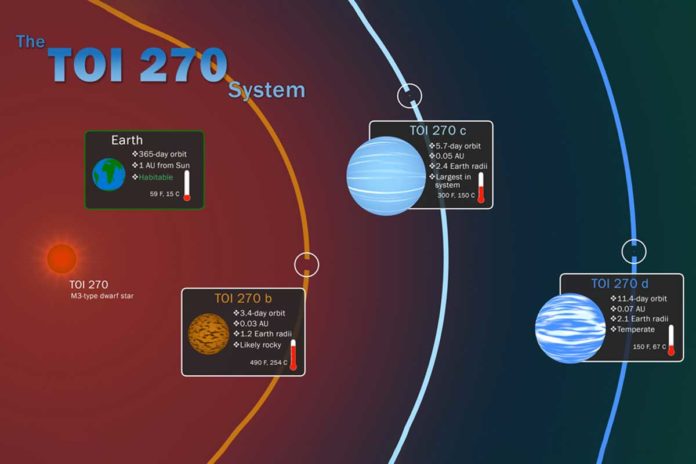NASA’s Transiting Exoplanet Survey Satellite, or TESS, has found three new worlds that are among the smallest, nearest exoplanets known to date. The planets circle a star only 73 light-years away and incorporate a small, rough super-Earth and two sub-Neptunes — planets about a large portion of the size of our own icy giant.
The sub-Neptune farthest out from the star seems, by all accounts, to be inside a temperate zone, implying that the highest point of planet’s atmosphere is inside a temperature extend that could support a few types of life. In any case, scientists state the planet’s atmosphere is likely a thick, ultradense heat trap that renders the planet’s surface too hot to even consider hosting water or life.
Scientists dubbed this new planetary system as TOI-270, proving to have other interesting qualities such as they appear to be of similar size. Moreover, TOI-270 appears to host two intermediate planets: both are sub-Neptunes and smaller than our own Neptune and not much larger than the rocky planet in the system.
According to astronomers, TOI-270 might be a ‘missing link’ in planetary formation, as they are of intermediate size and could help researchers determine whether small, rocky planets like Earth and more massive, icy worlds like Neptune follow the same formation path or evolve separately.

Maximilian Günther, a postdoc in MIT’s Kavli Institute for Astrophysics and Space Research said, “There are a lot of little pieces of the puzzle that we can solve with this system. You can really do all the things you want to do in exoplanet science, with this system.”
Astronomers detected these planets by looking through measurements of stellar brightness taken by TESS. Then by using MIT-developed satellite to observe characteristic dips in brightness that could flag a planet briefly blocking the star’s light as it goes before it.
The group secluded a few such signals from a nearby star, found 73 light-years away in the southern sky. They named the star TOI-270, for the 270th “TESS Object of Interest” recognized to date.
Using ground-based instruments to catch up with respect to the star’s action, astronomers affirmed that the signals are the consequence of three orbiting exoplanets: planet b, a rough super-Earth with an around three-day orbit; planet c, a sub-Neptune with a five-day orbit; and planet d, another sub-Neptune marginally farther, with a 11-day orbit.
Günther said, “For TOI-270, these planets line up like pearls on a string. That’s a very interesting thing because it lets us study their dynamical behavior. And you can almost expect, if there are more planets, the next one would be somewhere further out, at another integer ratio.”
“There is a good possibility that the system hosts other planets, further out from planet d, that might well lie within the habitable zone. Planet d, with an 11-day orbit, is about 10 million kilometers out from the star.”
“Given that the star is small and relatively cool — about half as hot as the sun — its habitable zone could potentially begin at around 15 million kilometers. But whether a planet exists within this zone, and whether it is habitable, depends on a host of other parameters, such as its size, mass, and atmospheric conditions.”
The details of the new planetary system are reported in the Nature Astronomy.
